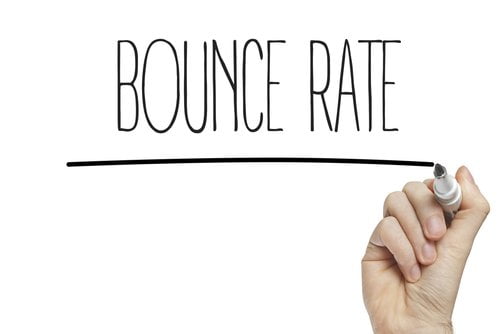Learn More About Us

Many businesses invest tens of thousands of dollars every month into SEO and SEM in order to generate traffic to their website, only to realize that large amounts of the traffic they’re receiving is leaving after viewing only a single page.
People that only visit one page on your website before leaving are called “bounces,” and the typical measure of bounce activity is “bounce rateThe percentage of visitors who leave a website after viewing only one page..” This metric is tracked by just about every analyticsThe systematic computational analysis of data or statistics to gain insights and support decision-ma... software available, including Google Analytics.
A high bounce rate is almost always undesirable. It indicates that your website isn’t gaining the trust of visitors, that your content isn’t engaging or that there’s simply no reason for visitors to stay after visiting the first page they reach.
Luckily, like many other metrics used to track marketing performance, bounce rate is relatively easy to reduce. These five strategies will help you reduce your bounce rate and get more attention and revenue from each visitor to your B2B website.
If you’re marketing your website using AdWordsGoogle’s online advertising platform, now known as Google Ads. PPC and notice an exceptionally high bounce rate, your advertisements may be promising more than your website actually delivers.
One of the most common causes of a high bounce rate is a mismatch between the promises in your advertising copy and your website’s content. Being deceptive or misleading will earn you a high CTR, but few of the clicks will be worth much.
If your landing pages have a high bounce rate (anything over 80% is high) it might pay to test variations of your advertising copy that make more modest claims to see if they keep visitors on your website for longer.
The key cause of high bounce rate for landing pages is a mismatch between sales-driven copy and the reality of the offerThe specific product or service being promoted by affiliates.. For blogs and content-driven websites, it’s slightly different; a mismatch between your audience and your content.
How engaging is your website’s content? If your blog posts have a high bounce rate from search traffic, it could be because your content simply isn’t interesting enough to keep readers interested and engaged.
Counter this cause of a high bounce rate by focusing on developing content that’s in-depth, engaging and informative. Make sure it matches your audience’s expectations and answers their questions; the better your content is, the longer they’ll stay.
Sometimes even great content isn’t enough to keep visitors on your website. If your blog post doesn’t leadA potential customer referred by an affiliate who has shown interest in the product or service but h... visitors anywhere, they’ll likely close the tab and visit another website.
Because of this, all of your blog posts and content-based pages should be a step in a longer content pathway. Add a list of your most popular blog posts to the end of all of your blog pages to funnel users towards your best content.
At the end of these pages, you can direct users towards your product and service pages and turn them into customers. Think of each page as a stepping stone that your audience can use; each one leads to another, which leads to another.
Meta descriptions are the short descriptions of your page content that Google uses to show searchers what your page is about. If you don’t write these yourself, they’ll often be generated dynamically by Google’s indexingThe process of adding web pages into a search engine's database. technology.
It’s important to write detailed, informative meta descriptions that closely match the content on your website. This way, searchers won’t visit your website with an expectation that your content will cover something it actually doesn’t cover.
Keep your meta descriptions clear, concise and accurate. The more information on your website’s content they give to searchers, the more likely they are to visit – and stay on – your website after seeing it in the search results.
No matter how extensively you optimize your website to reduce bounce rate, you’ll never keep every user on-site forever. The average bounce rate for many websites is upwards of 60 percent – a reality that no amount of optimization can fix.
While it’s reduce to minimize your bounce rate, you’ll never be able to end bounces altogether. Focus on maximizing the value you can provide for the traffic you have, and don’t worry too much about capturing the attention of every visitor.
Do this by understanding your audience and targeting your content to answer their questions. Remember that it’s better to engage half of your audience than to keep a far larger number of people on-site without truly connecting with them.
